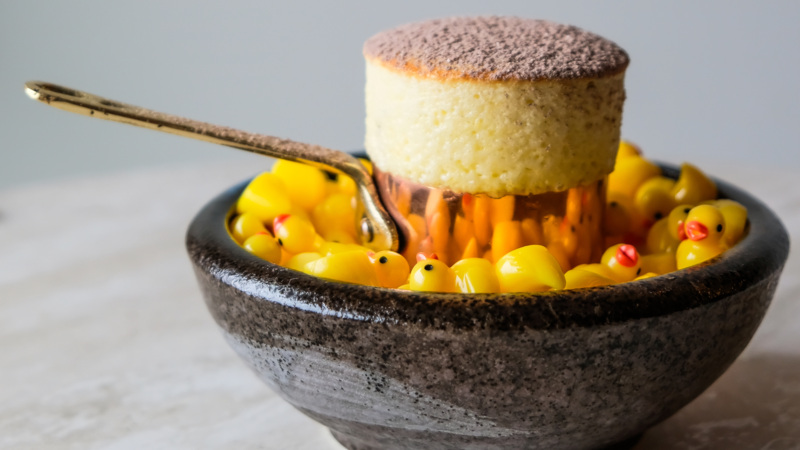
Is Italian Village Keeping Chicago’s Biggest Wine Secret?
The quiet pervades the Italian Village’s climate-controlled wine cellar, which is perched implausibly on the top floor of this three-restaurants-in-one temple to Italian cookery in Chicago’s Loop. Like the nostalgic, red-sauce juggernaut it supplies, the so-called “cellar in the sky” isn’t exactly posh or stocked with cool kid wines, but it’s a treasure all the same and the sort rarely found anymore — maybe most notable for its startling value.
The Capitaninis, who founded the Italian Village restaurant group in 1927 and still operate it via third-generation owner Gina, built the cellar from the ground up starting in 1981. Today the collection counts upward of 30,000 bottles, representing 1,200 different labels and vintages from around the world. It has become a treasure trove for serious wine drinkers, if one that remains something of an insider’s secret in Chicago — and helped put this 93-year-old restaurant group, which comprises Italian-American classic the Village, pasta-focused Vivere, and subterranean chophouse La Cantina, on the map.
For wine director Jared Gelband, the pricing seemed at first like a mistake: verticals of Le Pergole Torte, one of the most legendary Chiantis (if not labeled as such) for $120 a bottle going back to the 1990s — barely more than you’d pay retail for a current release. Or 20 vintages of Super Tuscans like Sassicaia and Masseto, in the $300 range, less than you’d often pay retail.
“For me, the initial shock of the cellar here was like when a guest opens up the book for the first time, and sees all these different verticals and vintages dating way back at those prices,” says Gelband, who came on board in 2016. “At first, I was like, this doesn’t seem right.”
➖
Related: Italian Village’s Century of Meat Sauce and Solace
➖
When he approached the owners about revisiting pricing, he quickly learned that the relatively low price point was a deliberate choice, made in the name of accessibility. “They don’t want guests to feel like they were abused on the way out because they saw their favorite vintage from their anniversary or birthday, or a time they were in Tuscany.”
Sustaining such a large list and buying bulk quantities of wines has helped the Italian Village hang onto vintage wines for long periods while only minimally adjusting prices over time. They can offer high-quality wines for affordable prices “because we got them at such a great price upon release,” Gelband explains.

Mentor and tormentor
None of this is coincidence. When second-generation owners Frank and Ray Capitanini took over the business from their father, founder Alfredo Capitanini, and opened the Florentine Room (now Vivere) in 1961, sweet, low-grade Virginia Dare wines still loomed large, and Chianti came only in liters. Aiming to push the selections to higher echelons, in 1981 Ray called on wine consultant Tom Abruzzini, whom he would later famously dub his “mentor and tormentor.” Marathon all-night tasting sessions and an introduction to Abruzzini’s vast network of importers and producers sparked a cellar rebuild that focused on classic wines spanning the length and breadth of Italy and its surrounding islands. The Capitaninis converted the top-floor liquor storage area into a cellar, which they climate-controlled at 57 degrees F for reds, 47 degrees F for whites. Soon enough, the restaurant began catching attention — and winning awards — for its wine choices.
During his four-year tenure, Gelband has trimmed the list: cutting back on wines from France and Spain that swelled before his arrival in favor of retraining the focus on staples and lesser-known Italian and Sicilian wines, from Calabrian gaglioppo to Sicilian frappato. He might turn California red drinkers onto fruity Montepulciano d’Abruzzo or Puglian negramaro, or nudge pinot noir lovers toward schiava from Alto Aldige or Sicilan nerello mascalese.
“It’s a lot of pressure maintaining this beast of a cellar so it doesn’t lose the integrity of what it is,” Gelband says. “Seeing the old classics on there, I know I’ve gotta keep this thing going, not just for myself, but for the wine director 10 years down the road.”
That means a balancing act of filling in gaps, selling what needs to go, and prepping for the future. Since the pandemic, Gelband is purchasing far less than this time last year, but regulars still call looking to recreate the experience of dining out at one of the group’s restaurants. “My favorite calls are, ‘Jared, just grab me something for $150. I love those people. They want to explore and learn.”

In a move that seems notably avant-garde for the Italian Village, Gelband started hosting Zoom wine dinners featuring different producers, and this month is launching regional wine kits, which feature three bottles from a specific region, along with maps and information on the wineries. As the holidays draw near, he’s preparing mulled wine kits with a bottle of house Chianti.
And even though dining in isn’t an option, and an unprecedented winter season looms, Gelband begins every shift with a cellar walkthrough, checking for subtle changes he might’ve overlooked.
“I’ve gotten in this habit everyday, just walking through and looking at different vintages and the dust on bottles; it really is very special,” he says. “These wines are still maturing, they don’t know anything going on in the world right now. They’re tucked away in the cellar in the sky, having their own life in the bottle.”
Maggie Hennessy is a Chicago-based restaurant critic and food writer, whose work has appeared in such publications as Eater, Plate, Food52, Wine Enthusiast and others. Follow her on Instagram and Twitter. Follow Resy, too.




















